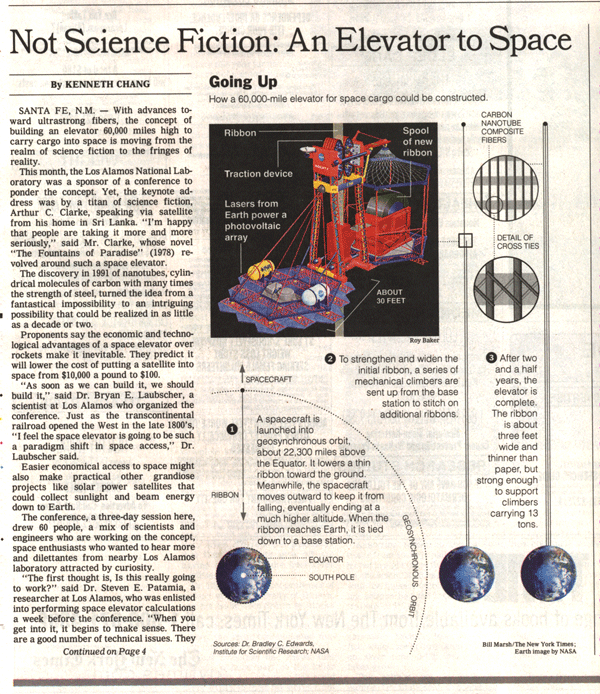|
| |
|
|
|
Type 1 Space TechnologiesThe Space Elevator The basic idea behind a space elevator is to tie a tether between the earth and an orbiting artificial satellite, then use the tether to transport things from the ground into space.   The biggest problem with engineering and building a space elevator is the material to be used for the massive 15-20 mile long tether cable... For this Engineers are thinking of using carbon nanotubes. From a space elevator platform we will then be able to construct larger space station platforms, which can act as future shuttle ports, or space hotels. Space RampsA massive rail-gun up the side of a muntainFrom Sky Ramp Technology Mankind needs an inexpensive method of launching spacecraft. For the past 48 years, the basic method has been multi-stage expendable rockets. There has always been great interest in a single-stage Reusable Launched Vehicle (RLV), to allow ordinary people to visit outer space for the same cost as a trip to Europe. In fact, today's "Space Shuttle" was envisioned as a single-stage RLV, but that proved impractical so two semi-reusable rocket boosters and massive disposable fuel tank are needed, which pushes the total cost for each mission over $500 million. As a result, hopes for 100 shuttle launches a year have dwindled to four a year. NASA canceled a more recent attempt at a single-stage RLV, the X-33/Venturestar, when problems proved insurmountable. The solution is a "Sky Ramp" assisted-launch to propel an RLV on a sled to supersonic speeds up a long inclined track before the RLV fires its engines. This can be done with today's rocket engines or pneumatic accelerators at less than 6 Gs from a variety of proven tracks. The sled can also launch any airborne vehicle, including Mach 3+ ramjet powered aircraft or spaceplanes. This does not require a technological breakthrough since scientists and engineers have proven this concept viable using existing technology. The Space Shuttle burns 40% of its fuel just to reach 1000 mph (Mach 1.3) because it struggles to push through the dense lower atmosphere with a full fuel load. NASA's maglev assisted launch studies showed that a 600 mph (Mach 0.8) assisted launch can reduce the required fuel by 25%, allowing a single-stage RLV to make orbit with a substantial payload. Assisted launch off a Sky Ramp is the only viable method of inexpensive space launch. This is the next leap forward in space launch. Halo RingsIn the movie starship troopers they had a space ring orbiting high above the earth that served as a astronomical observatory array, as well as a space defense array. 
You start by building a long chain or tether which can loop around the entire earth in orbit. One method would be to launch many small cargo containers into orbit and then chain them all together in space and start a platform to begin building off of. 
The idea is to build a mega-structure around the earth in the form of a Halo ring, starting from the chain of orbiting satellites and then eventually growing bigger in scale. Once the Halo rings are complete they could also be launched into space as gigantic space stations. |